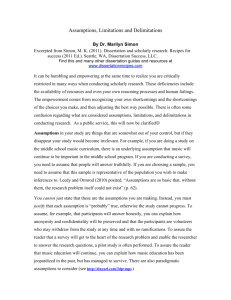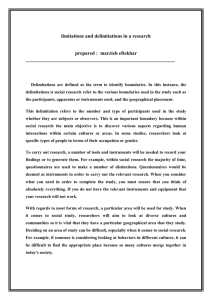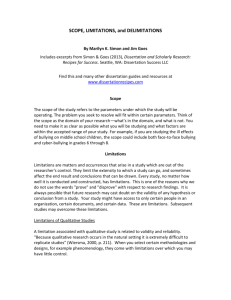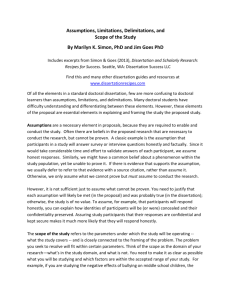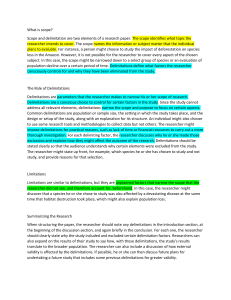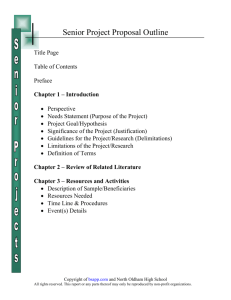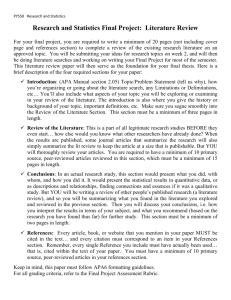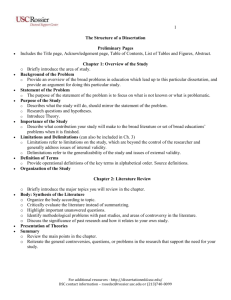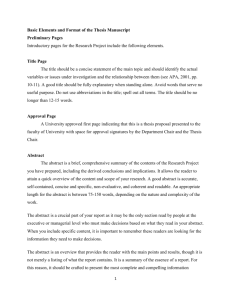Community answer(limitation,delimitation)
advertisement
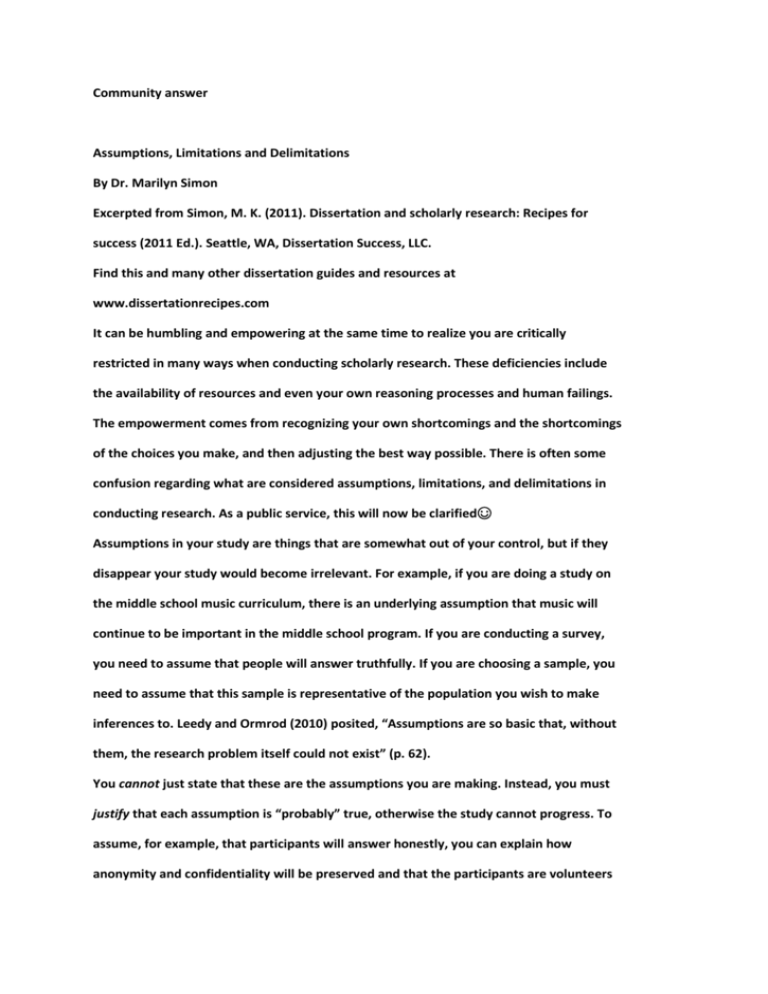
Community answer Assumptions, Limitations and Delimitations By Dr. Marilyn Simon Excerpted from Simon, M. K. (2011). Dissertation and scholarly research: Recipes for success (2011 Ed.). Seattle, WA, Dissertation Success, LLC. Find this and many other dissertation guides and resources at www.dissertationrecipes.com It can be humbling and empowering at the same time to realize you are critically restricted in many ways when conducting scholarly research. These deficiencies include the availability of resources and even your own reasoning processes and human failings. The empowerment comes from recognizing your own shortcomings and the shortcomings of the choices you make, and then adjusting the best way possible. There is often some confusion regarding what are considered assumptions, limitations, and delimitations in conducting research. As a public service, this will now be clarified☺ Assumptions in your study are things that are somewhat out of your control, but if they disappear your study would become irrelevant. For example, if you are doing a study on the middle school music curriculum, there is an underlying assumption that music will continue to be important in the middle school program. If you are conducting a survey, you need to assume that people will answer truthfully. If you are choosing a sample, you need to assume that this sample is representative of the population you wish to make inferences to. Leedy and Ormrod (2010) posited, “Assumptions are so basic that, without them, the research problem itself could not exist” (p. 62). You cannot just state that these are the assumptions you are making. Instead, you must justify that each assumption is “probably” true, otherwise the study cannot progress. To assume, for example, that participants will answer honestly, you can explain how anonymity and confidentiality will be preserved and that the participants are volunteers who may withdraw from the study at any time and with no ramifications. To assure the reader that a survey will get to the heart of the research problem and enable the researcher to answer the research questions, a pilot study is often performed. To assure the reader that music education will continue, you can explain how music education has been jeopardized in the past, but has managed to survive. There are also paradigmatic assumptions to consider (see http://tinyurl.com/3dpvmps ) ½ cup Limitations, Delimitations (scope) Limitations are potential weaknesses in your study and are out of your control. We find limitations in almost everything we do. If you are using a conventional oven, food in the middle racks often are undercooked while the food closest to the burner and the top can be too well done. If you are using a sample of convenience, as opposed to a random sample, then the results of your study cannot be generally applied to a larger population, only suggested. If you are looking at one aspect, say achievement tests, the information is only as good as the test itself. Another limitation is time. A study conducted over a certain interval of time is a snapshot dependent on conditions occurring during that time. You must explain how you intend to deal with the limitations you are aware of so as not to affect the outcome of the study. The delimitations are those characteristics that limit the scope and define the boundaries of your study. The delimitations are in your control. Delimiting factors include the choice of objectives, the research questions, variables of interest, theoretical perspectives that you adopted (as opposed to what could have been adopted), and the population you choose to investigate. Your first delimitation was the choice of problem itself; implying there are other related problems that could have been chosen but were rejected or screened off from view. Your purpose statement explains the intent that clearly sets out the intended accomplishments, and also includes and implicit or explicit understanding of what the study will not cover. The delimitations section of your study will explicate the criteria of participants to enroll in your study, the geographic region covered in your study, and the profession or organizations involved. A study about educators in California would not necessarily be applicable to other geographic regions or other professions. An example could be: The results of this study could be generalizable to educators who (a) teach middle school children in a college oriented charter school, (b) in the state of California and (c) have taught more than ten years in the middle school classroom. You can also give a philosophical framework to limit your study. When you prepare a meal, you get to determine how many vegetables you will serve. You will delineate special characteristics of your sample and the population that it comes from. The selected methodology and variables in your study also set a boundary on what your findings can ascertain. When writing your proposal and dissertation, it is important to convince your reader of the potential impact of your study. You need to communicate these possibilities with a sense of enthusiasm and confidence, but without exaggerating the merits of what your research could accomplish. That is why it is so important to explicate the assumptions, limitations, and delimitations of the investigation. References Leedy, P.D. & Ormrod, J. E. (2010) Practical Research: Planning and Design, Ninth Edition. NYC: Merril. Simon, M. K. (2011). Dissertation and scholarly research: Recipes for success (2011 Ed.). Seattle, WA, Dissertation Success, LLC. Note: When you are elaborating on the nature of your study or on the limitations and delimitations of your study, you might wish to consider the following: Ontology - How you, the researcher, views reality: Objectively? Subjectively? A combination of the two? Epistemology - The methods you use to derive, elicit, and analyze data. Theory -What interrelated constructs, definitions, and propositions you use to present a systematic view of the phenomenon under investigation. You need to specify relations among variables with the purpose of describing, explaining, and predicting the phenomenon you are studying. Community answer Delimitations are defined as the term to identify boundaries. In this instance, the delimitations is social research refer to the various boundaries used in the study such as the participants, apparatus or instruments used, and the geographical placement. Types of Delimitations: Participants This delimitation refers to the number and type of participants used in the study whether they are subjects or observers. This is an important boundary because within social research the main objective is to discover various aspects regarding human interactions within certain cultures or areas. In some studies, researchers look at specific types of people in terms of their occupation or gender. Apparatus or Instruments To carry out research, a number of tools and instruments will be needed to record your findings or to generate them. For example, within social research the majority of time, questionnaires are used to make a number of distinctions. Questionnaires would be deemed as instruments in order to carry out the relevant research. When you consider what you need in order to complete the study, you must ensure that you think of absolutely everything. If you do not have the relevant instruments and equipment that your research will not work. Geographical Placement With regards to most forms of research, a particular area will be used for study. When it comes to social study, researchers will aim to look at diverse cultures and communities so it is vital that they have a particular geographical area that they study. Deciding on an area of study can be difficult, especially when it comes to social research. For example, if someone is considering looking at behaviors in different cultures, it can be difficult to find the appropriate place because so many cultures merge together in today's society. What is a limitation within an experiment? In short, limitations are matters and occurrences that arise in an experiment that are totally out of the researcher's control. They limit the extensity that a study can go to, sometimes affecting the end result of the investigation. For example, in a school district, a researcher could have restrictions, permitting them to carry out their explorations and inquiries at particular times of the academic year only. This would be considered as a limitation within the experiment; there is nothing that the researcher can do to change this scenario, no matter how problematic it may prove to be in finding out what it is they need to know. What is delimitation within an experiment? Delimitations are boundaries that are set by the by the researcher in order to control the range of a study. They are created before any investigations are carried out, in order to reduce the amount of time spent in certain areas that may be seen to be unnecessary, and perhaps even unrelated, to the overall study. An example of this would be if a study was delimited to questioning people within a certain age group only, or to refrain from moving from within a certain area, whether it is a big region, such as a whole state, or a smaller one, such as a town or village within it. Why limitations and delimitations are considered Although thinking about the various limitations and delimitations that may occur within an experiment can be time consuming, it is necessary to the overall outcome of the experiment, and ensures that the proceeding can run ahead without any unforeseen stipulations, some of which could prove both costly and detrimental to the investigations being carried out.
